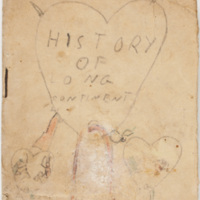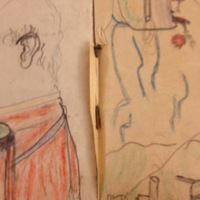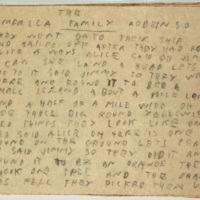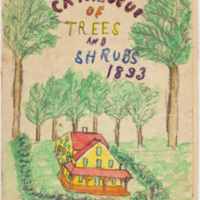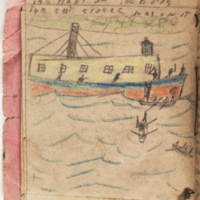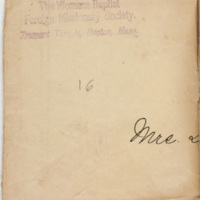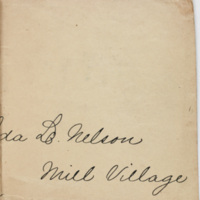Materials
The Nelson brothers employed a variety of binding style and paper arrangements in order to produce their books. Methods of construction were most probably taken from a variety of resources, including Youth’s Companion and other instructional pieces, as well as from first-hand encounters with more locally produced books. Materials seem commonplace, often times being taken from household documents; bindings are often simply constructed from string and pins. Interestingly, the overall construction of each piece seems to be independent of the contents, or lack thereof, contained in the book.
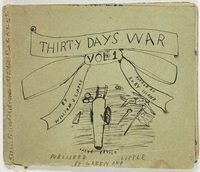
The carefully sewn cover of Thirty Days War.
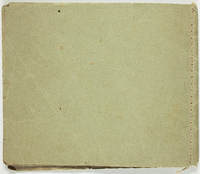
The back cover of Thirty Days War. Note how the stitches run through the front and back covers rather than through the folded edge.
Bindings
The physical construction of each of the Nelson brothers’ volumes varies from book to book. Some pieces were put together with a small pin, threaded through their folded edges, while others were assembled with the usage of thread and a needle. Depending on the number of pages, these sewn bindings range from a single stitch (found in the Chit Chat:December, January, February, undated) to a full row of stitches (as with Thirty Days War). And even still, others remain unfinished and unbound. Ironically enough, some of the best-constructed pieces contribute little to the wealth of stories created by the brothers. A Partridge takes only a page, written front and back, of a small (1⅞‘’ x 2½‘’) volume stitched securely, whereas Seven Days in the Country: Ch. 1 and Ch. 4 consists of multiple chapters of a novel but was not bound together whatsoever.
While locating the exact source of the Nelsons’ binding inspirations may prove futile, much information can be gleaned from potential sources of information available at the time. The Amherst College Archives & Special Collections own several miniature books printed in 1844 and 1845 in Greenfield, Massachusetts. These children’s volumes, entitled A.B.C. Book, Lazy Ned, and Pictures of Animals, are all sewn similarly to the Nelson brothers’ volumes. Though these books predate the Nelsons, the presence of similar texts in the Nelson household would not have been a rare occurence.
Similarly, several issues of Youth’s Companion contain instructions on how to create different kinds of books. In the directions for one, a ribbon notebook, readers are instructed to sew across the top of the ribbon, which holds the pages of the book.
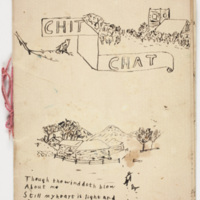
The cover a Chit Chat issue. This binding is much simpler in design than that of Thirty Days War; it is held together with only one stitch.
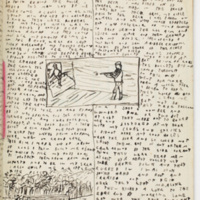
Inside detail of a Chit Chat issue. The bright pink binding string runs through the middle of the page.
There seem to be a variety of methods that the Nelsons took in arranging the pages in their booklets. Those bound with a pin and some sewn together with string are constructed by placing folded leaflets within one another. Periodicals were almost always assembled in this manner. This is the proper practice, according to an article from The Independent. Here, the author states “it is customary to sew together folded leaves of the size and thickness of the intended book” (*). Other works from the Nelson collection consist of folded leaflets stacked on top of one another. This is the case for works like the Nelson Bros. Novelties. Here, the typical method for sewing into the folded side was not used; instead, stitches run a centimeter in from the left side of the book.
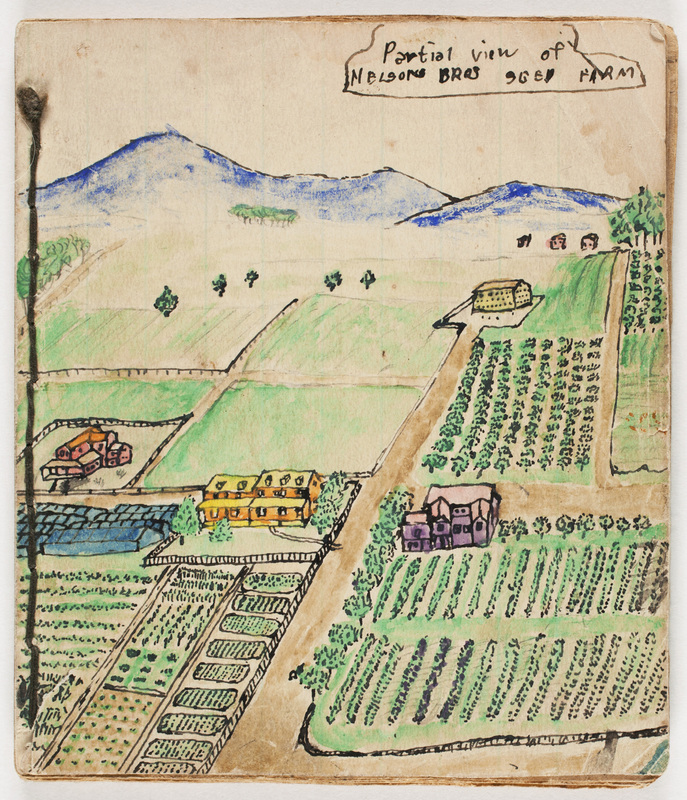
This cover, done in watercolors and pen, excellently conveys the amount of effort the Nelsons put into finalizing their products (taken from the Nelson Bros. Seedsman).
Covers
The care and thought with which the Nelsons approached their works not only applies to the plotlines and characters of the books; the covers of their books also prove to be well planned and quite remarkable visually. This is not to say, though, that every work in the collection has been carefully covered; like the variety in book bindings found in the collection, covers range from non-existent to carefully drawn and illustrated.
Many evidently valued aesthetics during the 1890s. Periodicals printed many articles, both for adults and adolescents, on the topic of covering books. A piece in Youth’s Companion discusses the importance of covering books so as to preserve the beauty of the book’s given cover for generations to come. Henry Wysham Lanier furthers this admiration of illustrations in an article in The Independent. He revels in the growing prevalence of pictures in books and pamphlets, attributing these advances in part to the photographical developments.
Many nineteenth-century publishers produced their books with consistent covers, so that multiple volumes formed a distinctive, easily recognizable, set. The brothers did this as well using the same scroll cover design they employed for Thirty Days War (above) on the cover of three other books with fairly different content (Different Stories , The Rought it Club, and Five Years in the White Mountains).
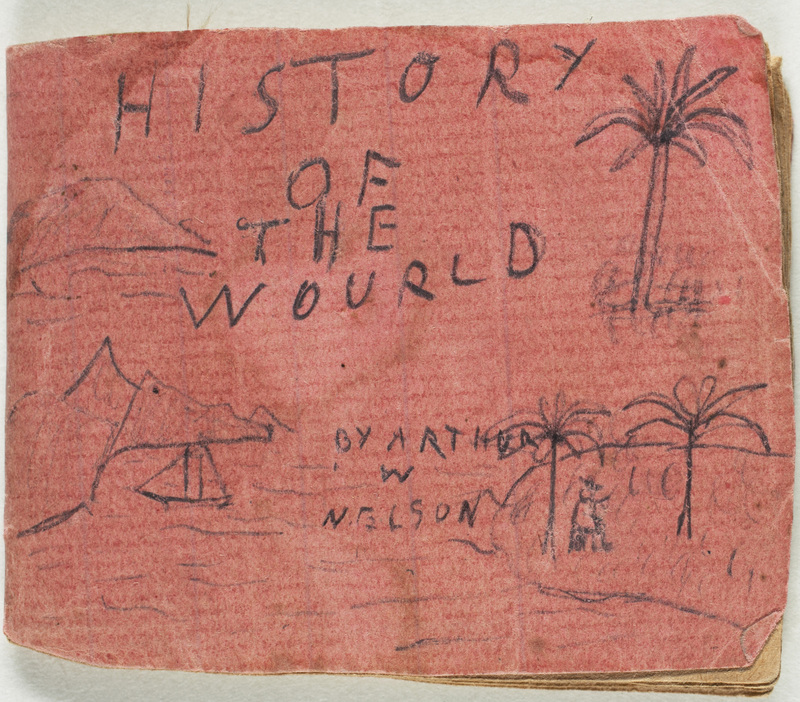
The bright red color of History of the Wourld's cover distinguishes the cover from the rest of the book (created with tan paper).
Even the locally printed books from Greenfield feature illustrative covers. Though simple in nature, these images give these books a more complete look and presumably would catch the eye of their young audience.
Likewise, those volumes from the Nelson collection with covers appear much more finalized in nature. Whether the cover was indicated through the utilization of a different color paper (as seen on the left) or through illustrations and/or the lack of narrative on the front page, the resulting product more closely resembles a book compared to those works without such a distinction. Often times, the Nelsons would cut their cover paper slightly larger than the pages inside (as with The Fight of the Boys) or use a different thickness of paper to subtly distinguish it from its contents. Certainly, these works (some pictured below) support the claim that the Nelsons strove for comparability to more professionally produced books.
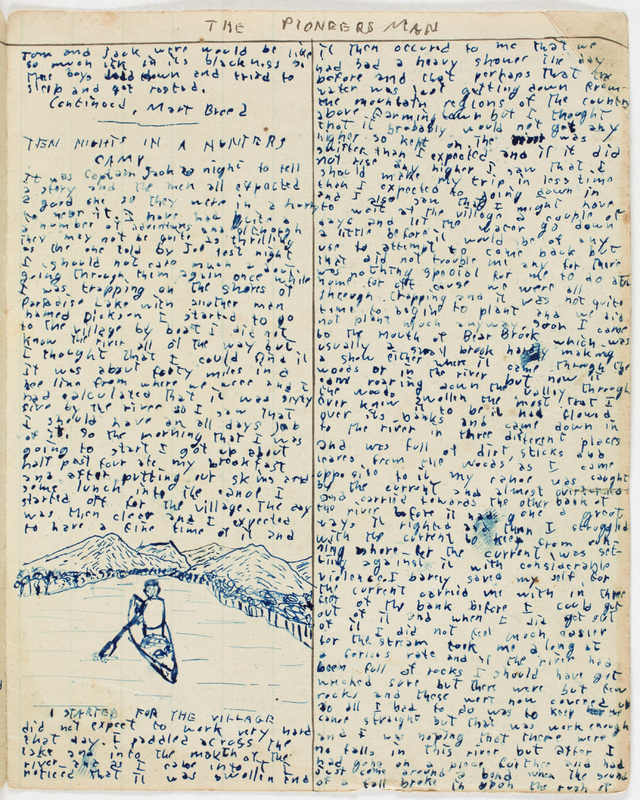
This particular issue of The Pioneersman was written entirely in blue pen. This page contains some editing (crossing out of text) as well as smudges and fingerprints.
Ink, Paper, and Pencils
Though covers on the works might give off an air of book-making expertise, the variation in writing implements as well as paper separates the Nelson’s works from those produced professionally.
The boys wrote the majority of their stories in pencil. This medium allows for the quick correction of spelling or formatting errors; however, the resulting product is more mutable than a printed work. A few select works (including the January 13, 1893 issue of The Pioneersman) were produced mainly in ink. Here, limitations include smudges and cross outs, but the product cannot be altered easily. Ink has an appearance more similar to printed works. Given the number of books, though, that were written in pencil, this part of the books’ appearances does not seem to have been as important to the Nelsons. The Nelsons also had access to a stamp or printing device of some sort; the headers of each installment of The Trapper were clearly created using some set method of lettering. For information about the materials used in the Nelsons’ illustrations, peruse the Illustrations section.
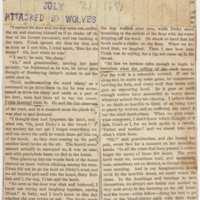
Each issue of The Trapper, a scrapbook series of periodical excerpts, begins with a title hand-printed with some sort of letter press. Here, the title, part of the date, and a summary of the issue's contents are all printed with this typeface.
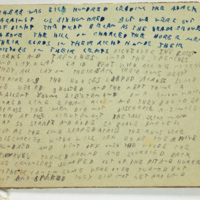
The pages in Thirty Days War vary in writing utencils. On this particular page, the author switches from writing in blue ink to writing in pencil.
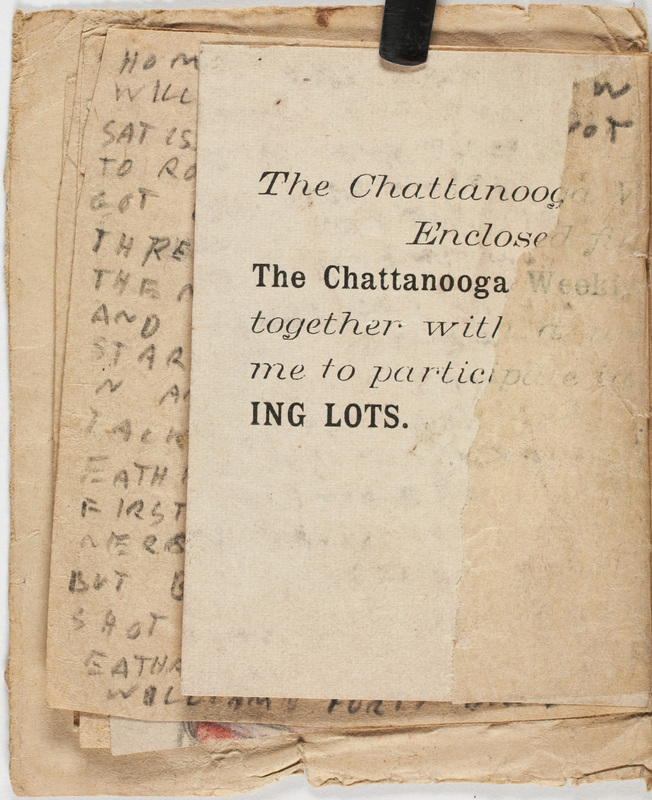
This image shows the back of one of the pages in History of Long Continent. The piece of paper advertises for a subscription to The Chatanooga Weekly.
The selection of papers utilized in the creation of the Nelson brothers’ collections suggests their resourcefulness. Pages from mailings and other paper-based products are often cut and reimagined as pages for the boys’ next book. For example, the leaves found in History of Long Continent consist mainly of recycled papers. The page comprising the front and back cover was once an envelope addressed to the Nelson’s mother, Ida. One of the pages within the book contains information about subscribing to the Chattanooga Weekly Times. Several other pages have lines of cursive writing written across the boys’ text.
Other books have less identifiable page sources. Thirty Days War, amongst a few others, is made out of thin green pages, while the tan paper utilized in Complete Geography of the World appears in many other volumes. There are a few others where lined paper is employed (often times, it has been rotated sideways so that the boys write perpendicular to the lines). Much like the bookbindings, there appears to be no clear reasoning behind the selection of paper source. Even issues of a single periodical use different materials. It appears that writing down the story was of much greater important to the boys compared to the place upon which it was writing; consistency was not, or possibly, could not be enforced in this sphere.
